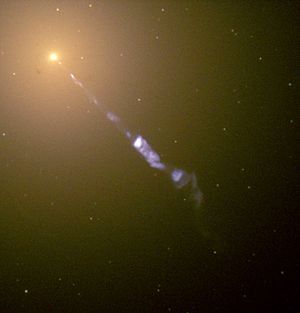Active galactic nucleus facts for kids
An active galactic nucleus (often called AGN) is a very bright and small area at the heart of some galaxies. This central spot shines with a huge amount of light and other energy. Scientists believe this energy comes from a supermassive black hole that is pulling in gas and dust.
When matter falls towards the black hole, it heats up a lot. This hot matter then shoots out energy across the entire electromagnetic spectrum. This means we can see it as radio waves, microwaves, infrared light, visible light, ultraviolet light, X-rays, and even gamma rays.
A galaxy that has an AGN at its center is called an active galaxy. AGNs are some of the brightest and most powerful sources of energy in the whole universe. They help us find very distant objects in space.
Contents
What Are Active Galactic Nuclei?
An active galactic nucleus is like a super-powered engine at the center of a galaxy. It is a very small area, but it gives off a huge amount of energy. This energy is much more than all the stars in the rest of the galaxy combined.
Scientists think that almost every large galaxy has a supermassive black hole at its center. But not all of them are "active." An AGN forms when this black hole is actively feeding. It pulls in a lot of gas and dust from its surroundings.
How Do AGNs Produce Energy?
When gas and dust get close to a supermassive black hole, they don't just fall straight in. Instead, they form a flat, spinning disk around the black hole. This is called an accretion disk.
As the material in the accretion disk spirals inward, it gets incredibly hot. It can reach millions of degrees Celsius. This extreme heat causes the material to glow brightly and release huge amounts of energy. This energy then shines out into space.
Types of Active Galaxies
Active galaxies are not all the same. They can look very different depending on how we observe them. This is because of how the AGN is angled towards us. It also depends on how much gas and dust surround the central black hole.
- Quasars: These are the most powerful and brightest types of AGNs. They are so bright that they can outshine their entire host galaxy. Quasars are often found very far away, meaning we see them as they were billions of years ago.
- Radio Galaxies: These active galaxies produce very strong radio waves. They often have giant jets of plasma shooting out from their centers. These jets can be much larger than the galaxy itself.
- Seyfert Galaxies: These are spiral galaxies with bright, active centers. Their light often shows strong emission lines, which are like fingerprints of hot gas.
- Blazars: These are a type of AGN where one of the powerful jets is pointed almost directly at Earth. This makes them appear very bright and rapidly changing.
Relativistic Jets from AGNs
Some AGNs, especially radio galaxies and quasars, shoot out incredibly powerful beams of plasma. These are called relativistic jets. "Relativistic" means they move at speeds very close to the speed of light.
These jets can stretch for thousands or even hundreds of thousands of light-years into space. They are made of charged particles and magnetic fields. The jets are a way for the black hole to release some of the energy from the infalling matter.
Why Are AGNs Important?
Active galactic nuclei are very important for understanding the universe. They are some of the most powerful objects we know.
- Understanding Black Holes: Studying AGNs helps scientists learn more about supermassive black holes. It shows how they grow and how they interact with their host galaxies.
- Galaxy Evolution: The energy from AGNs can affect how galaxies grow and change over time. They can either help form new stars or stop star formation.
- Cosmic Distances: Because AGNs are so bright, we can see them from very far away. This helps astronomers measure vast distances in the universe. It also helps us understand how the universe has changed over billions of years.
Images for kids
-
Quasar 3C 273 observed by the Hubble Space Telescope.
See also
 In Spanish: Galaxia activa para niños
In Spanish: Galaxia activa para niños





